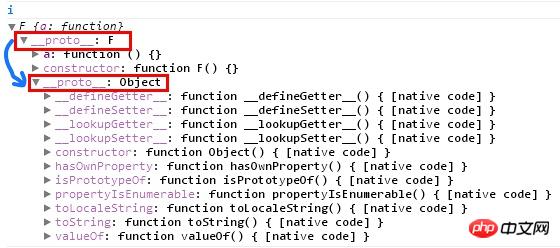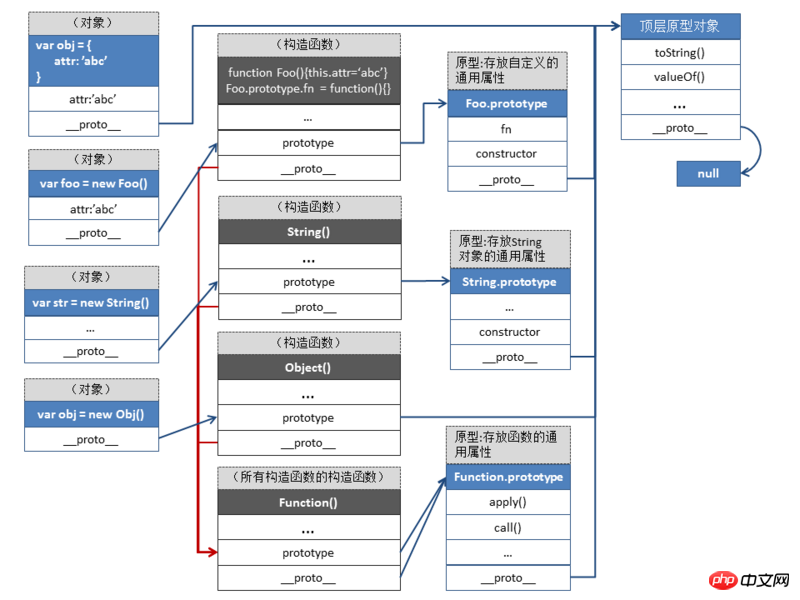Comprehensive analysis of prototypes in JavaScript
This article mainly introduces the complete analysis of prototype prototype in JavaScript. Prototype is an important support for the "everything is an object" argument in the js world. It explains the __proto__ attribute and prototype chain and other dry information. Friends who need it can refer to it
To understand prototype in JS, you must first understand the following concepts
1. Everything in JS is an object
2. Everything in JS is derived from Object Comes from, that is, the end point of the prototype chain of all things points to Object.prototype
1 2 3 4 |
|
3. The subtle relationship between constructors and instances (objects) in JS
The constructor agrees on its instance by defining prototype Specifications, and then use new to construct instances, their role is to produce objects.
And the constructor (method) itself is an instance of the method (Function), so its __proto__ (prototype chain) can also be found
Object / function F() {} This is the constructor, one is provided by JS native API, and the other is customized
new Object() / new F() This is what it looks like Example
An instance can "only" check __proto__ to know what prototype it is based on,
but "cannot" redefine the prototype of the instance to create an instance of the instance.
Practice brings true knowledge, only by observing/thinking yourself can you truly understand:
1 2 3 4 5 6 7 8 |
|
You may be dizzy, let’s break it down.
prototype The format of prototype output is: constructor name prototype
First, let’s take a look at what Object.prototype outputs?
Object {} -> The previous Object is a constructor The name of the function, the last one represents the prototype, here is a {}, that is, an instance of an Object object (empty object)
Then we will understand what F {} means, F is the name of the constructor, and the prototype is also An empty object
1 2 3 4 5 6 7 8 |
|
Let’s go a little deeper and define the prototype of F to see what happens?
1 2 3 4 5 |
|
In this way we can clearly see that i is constructed from F, The prototype is {a: function}, which means that the original empty object prototype has a new a method
Let’s change the situation again, what will happen if we completely cover the prototype of F?
1 2 3 4 5 6 7 |
|
Why~ Why does it show that i is constructed from Object? No!
Because we completely overwrite the prototype of F, which actually means specifying the prototype as object {a: function}, but this will cause the original The constructor information is lost and becomes the constructor specified by the object {a: function}.
So what is the constructor of the object {a: function}?
Because the object {a: function} is actually relative to
1 |
|
Then of course the constructor of o is Object
Let’s correct this mistake
1 2 3 4 5 6 7 8 9 |
|
Now we can get the correct prototype information again~
Prototype chain
Then let’s take a look at what the prototype chain is?
Simply speaking, it is the same as the inheritance relationship (chain) in OOP. You go up layer by layer. , until the final Object.prototype

Another thing to understand is that any object has a prototype!
1 2 3 4 5 6 7 8 9 10 11 12 13 14 15 |
|
Prototype and __proto__Each object contains a __proto__, pointing to the "prototype" of this object. A similar thing is that each function contains a prototype. What does this prototype object do?
1 2 3 |
|

1 2 3 4 5 |
|

1 |
|
1 2 |
|
foo.__proto__到底要指向谁了?你怎么不能指向Foo这个函数本身吧,虽然函数也是对象,这个有机会会详细讲。但如何foo.__proto__指向Foo固然不合适,因为Foo是一个函数,有很多逻辑代码,foo作为一个对象,继承逻辑处理没有任何意义,它要继承的是“原型对象”的属性。
所以,每个函数会自动生成一个prototype对象,由这个函数new出来的对象的__proto__就指向这个函数的prototype。
1 |
|
总结说了这么多,感觉还是没完全说清楚,不如上一张图。我曾经参考过其他网友的图,但总觉得哪里没说清楚,所以我自己画了一张图,如果觉得我的不错,请点个赞!(老子可是费了牛劲才画出来)。

咱们就着这张图,记住如下几个事实:
1. 每个对象中都有一个_proto_属性。
JS世界中没有类(模具)的概念,对象是从另一个对象(原型)衍生出来的,所以每个对象中会有一个_proto_属性指向它的原型对象。(参考左上角的那个用字面量形式定义的对象obj,它在内存中开辟了一个空间存放对象自身的属性,同时生成一个_proto_指向它的原型——顶层原型对象。)
2. 每个函数都有一个prototype属性。
“构造函数”为何叫构造函数,因为它要构造对象。那么根据上面第一条事实,构造出来的新对象的_proto_属性指向谁了?总不能指向构造函数自身,虽然它也是个对象,但你不希望新对象继承函数的属性与方法吧。所以,在每个构造函数都会有一个prototype属性,指向一个对象作为这个构造函数构造出来的新对象的原型。
3. 函数也是对象。
每个函数都有一些通用的属性和方法,比如apply()/call()等。但这些通用的方法是如何继承的呢?函数又是怎么创建出来的呢?试想想,一切皆对象,包括函数也是对象,而且是通过构造函数构造出来的对象。那么根据上面第二条事实,每个函数也会有_proto_指向它的构造函数的prototype。而这个构造函数的函数就是Function,JS中的所有函数都是由Function构造出来的。函数的通用属性与方法就存放在Function.prototype这个原型对象上。
上面是我整理给大家的,希望今后会对大家有帮助。
相关文章:
全面分析JavaScript面向对象概念中的Object类型与作用域(附有示例)
详细解读JavaScript设计模式开发中的桥接模式(高级篇)
The above is the detailed content of Comprehensive analysis of prototypes in JavaScript. For more information, please follow other related articles on the PHP Chinese website!

Hot AI Tools

Undresser.AI Undress
AI-powered app for creating realistic nude photos

AI Clothes Remover
Online AI tool for removing clothes from photos.

Undress AI Tool
Undress images for free

Clothoff.io
AI clothes remover

Video Face Swap
Swap faces in any video effortlessly with our completely free AI face swap tool!

Hot Article

Hot Tools

Notepad++7.3.1
Easy-to-use and free code editor

SublimeText3 Chinese version
Chinese version, very easy to use

Zend Studio 13.0.1
Powerful PHP integrated development environment

Dreamweaver CS6
Visual web development tools

SublimeText3 Mac version
God-level code editing software (SublimeText3)

Hot Topics
 1393
1393
 52
52
 1205
1205
 24
24
 How to implement an online speech recognition system using WebSocket and JavaScript
Dec 17, 2023 pm 02:54 PM
How to implement an online speech recognition system using WebSocket and JavaScript
Dec 17, 2023 pm 02:54 PM
How to use WebSocket and JavaScript to implement an online speech recognition system Introduction: With the continuous development of technology, speech recognition technology has become an important part of the field of artificial intelligence. The online speech recognition system based on WebSocket and JavaScript has the characteristics of low latency, real-time and cross-platform, and has become a widely used solution. This article will introduce how to use WebSocket and JavaScript to implement an online speech recognition system.
 Recommended: Excellent JS open source face detection and recognition project
Apr 03, 2024 am 11:55 AM
Recommended: Excellent JS open source face detection and recognition project
Apr 03, 2024 am 11:55 AM
Face detection and recognition technology is already a relatively mature and widely used technology. Currently, the most widely used Internet application language is JS. Implementing face detection and recognition on the Web front-end has advantages and disadvantages compared to back-end face recognition. Advantages include reducing network interaction and real-time recognition, which greatly shortens user waiting time and improves user experience; disadvantages include: being limited by model size, the accuracy is also limited. How to use js to implement face detection on the web? In order to implement face recognition on the Web, you need to be familiar with related programming languages and technologies, such as JavaScript, HTML, CSS, WebRTC, etc. At the same time, you also need to master relevant computer vision and artificial intelligence technologies. It is worth noting that due to the design of the Web side
 WebSocket and JavaScript: key technologies for implementing real-time monitoring systems
Dec 17, 2023 pm 05:30 PM
WebSocket and JavaScript: key technologies for implementing real-time monitoring systems
Dec 17, 2023 pm 05:30 PM
WebSocket and JavaScript: Key technologies for realizing real-time monitoring systems Introduction: With the rapid development of Internet technology, real-time monitoring systems have been widely used in various fields. One of the key technologies to achieve real-time monitoring is the combination of WebSocket and JavaScript. This article will introduce the application of WebSocket and JavaScript in real-time monitoring systems, give code examples, and explain their implementation principles in detail. 1. WebSocket technology
 Essential tools for stock analysis: Learn the steps to draw candle charts with PHP and JS
Dec 17, 2023 pm 06:55 PM
Essential tools for stock analysis: Learn the steps to draw candle charts with PHP and JS
Dec 17, 2023 pm 06:55 PM
Essential tools for stock analysis: Learn the steps to draw candle charts in PHP and JS. Specific code examples are required. With the rapid development of the Internet and technology, stock trading has become one of the important ways for many investors. Stock analysis is an important part of investor decision-making, and candle charts are widely used in technical analysis. Learning how to draw candle charts using PHP and JS will provide investors with more intuitive information to help them make better decisions. A candlestick chart is a technical chart that displays stock prices in the form of candlesticks. It shows the stock price
 How to use JavaScript and WebSocket to implement a real-time online ordering system
Dec 17, 2023 pm 12:09 PM
How to use JavaScript and WebSocket to implement a real-time online ordering system
Dec 17, 2023 pm 12:09 PM
Introduction to how to use JavaScript and WebSocket to implement a real-time online ordering system: With the popularity of the Internet and the advancement of technology, more and more restaurants have begun to provide online ordering services. In order to implement a real-time online ordering system, we can use JavaScript and WebSocket technology. WebSocket is a full-duplex communication protocol based on the TCP protocol, which can realize real-time two-way communication between the client and the server. In the real-time online ordering system, when the user selects dishes and places an order
 How to implement an online reservation system using WebSocket and JavaScript
Dec 17, 2023 am 09:39 AM
How to implement an online reservation system using WebSocket and JavaScript
Dec 17, 2023 am 09:39 AM
How to use WebSocket and JavaScript to implement an online reservation system. In today's digital era, more and more businesses and services need to provide online reservation functions. It is crucial to implement an efficient and real-time online reservation system. This article will introduce how to use WebSocket and JavaScript to implement an online reservation system, and provide specific code examples. 1. What is WebSocket? WebSocket is a full-duplex method on a single TCP connection.
 JavaScript and WebSocket: Building an efficient real-time weather forecasting system
Dec 17, 2023 pm 05:13 PM
JavaScript and WebSocket: Building an efficient real-time weather forecasting system
Dec 17, 2023 pm 05:13 PM
JavaScript and WebSocket: Building an efficient real-time weather forecast system Introduction: Today, the accuracy of weather forecasts is of great significance to daily life and decision-making. As technology develops, we can provide more accurate and reliable weather forecasts by obtaining weather data in real time. In this article, we will learn how to use JavaScript and WebSocket technology to build an efficient real-time weather forecast system. This article will demonstrate the implementation process through specific code examples. We
 Simple JavaScript Tutorial: How to Get HTTP Status Code
Jan 05, 2024 pm 06:08 PM
Simple JavaScript Tutorial: How to Get HTTP Status Code
Jan 05, 2024 pm 06:08 PM
JavaScript tutorial: How to get HTTP status code, specific code examples are required. Preface: In web development, data interaction with the server is often involved. When communicating with the server, we often need to obtain the returned HTTP status code to determine whether the operation is successful, and perform corresponding processing based on different status codes. This article will teach you how to use JavaScript to obtain HTTP status codes and provide some practical code examples. Using XMLHttpRequest




